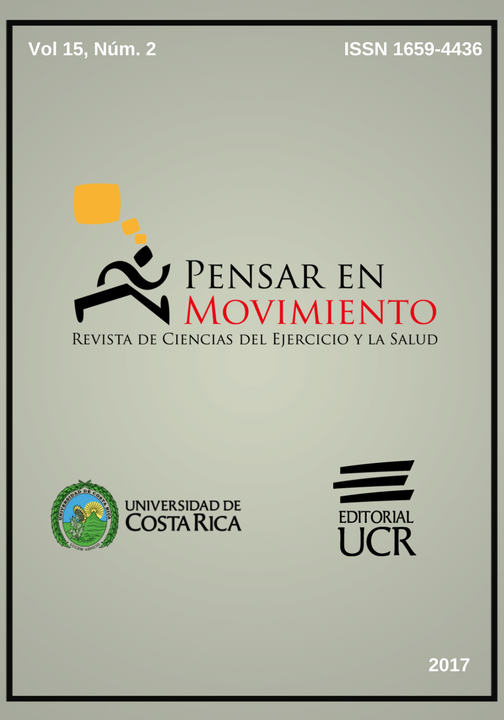Abstract
The aim of the study was to determine the effect of resistance-training exercise performed at different intensities on blood pressure (BP) in normotensives. Ten males (age = 38.2±7.0 yrs.; body weight = 75.2±5.4 kg; body height = 169±7.0 cm; resting BP = 116±7.5/71±7.3 mmHg) participated in four resistance-training exercise sessions performed in different days. The first session was used to determine one repetition maximum (1RM) for each resistance-training exercise; the following three sessions were randomly assigned and consisted of: a) seven resistance-training exercises performed at 50% of 1RM (2 sets x 14 reps); b) seven resistance-training exercises performed at 70% of 1RM (2 sets x 10 reps); and c) control condition (35-min quiet resting). Resting BP was measured before exercise, immediately following exercise, and at 10-min intervals for 60-min. Two-way repeated measures ANOVAs showed (p<0.05) that: (1) the systolic BP significantly decreased 20-min following exercise in the 70% 1RM condition compared to the control condition and the measurement before exercise; (2) the diastolic BP was significantly reduced following both exercise intensities compared to the measurements obtained before exercise and compared to the control condition. The acute effects lasted longer following exercise at 50% of 1RM. In conclusion, both resistance-training exercise intensities elicited a post-exercise hypotensive effect in normotensive participants.
References
Baum, K., Rüther, T., & Essfeld, D. (2003). Reduction of blood pressure response during strength training through intermittent muscle relaxations. International Journal of Sports Medicine, 24(6), 441-445. Doi: https://doi.org/10.1055/s-2003-41172
Bermudes, A.M., Vassallo, D.V., Vasquez, E.C., & Lima, E.G. (2003). Ambulatory blood pressure monitoring in normotensive individuals undergoing two single exercise sessions. Resistive exercise training and aerobic exercise training. Arq Bras Cardiol, 82(1), 65-71. Recuperado de: http://www.scielo.br/pdf/abc/v82n1/
en_a06v82n1.pdf
Canuto, P.M.B.C., Nogueira, I.D.B., Cunha, E.S., Ferreira, G.M.H., Mendoça, K.M.P.P., Costa, F.A., & Nogueira, P.A.M.S. (2011). Influence of resistance training performed at different intensities and same work volume over BP of elderly hypertensive female patients. Revista Brasileira de Medicina do Esporte, 17(4), 246-249. Doi: https://doi.org/10.1590/S1517-86922011000400006
Cardoso, C. G., Gomides, R.S., Queiroz, A.C.C., Pinto, L.G., Lobo, F.S., Tinucci, T.,... Forjaz, C.L.M. (2010). Acute and chronic effects of aerobic and resistance exercise on ambulatory blood pressure. Clinics, 65(3), 317-25. Doi: https://doi.org/10.1590/S1807-59322010000300013
Carpio, E. y Solera, A. (2012). Efecto agudo de circuitos de ejercicios aeróbicos, contra resistencia o combinados sobre la presión arterial de mujeres con hipertensión. Pensar en Movimiento: Revista de Ciencias del Ejercicio y la Salud, 10(2), 1-12. Doi: https://doi.org/10.15517/pensarmov.v10i2.3454
Carpio-Rivera, E., Moncada-Jiménez, J., Salazar-Rojas, W., & Solera-Herrera, A. (2016). Acute effects of exercise on blood pressure: A meta-analytic investigation. Arquivos Brasileiros de Cardiologia. 106(5), 422-33. Doi: https://doi.org/10.5935/abc.20160064
Chobanian, A., Bakris, H.R, Black, H.R., Cuschman, W.C., Green, L.A., Izzo, J.L.,... Rocella, E.J. (2003). The 7th report of the Joint Nacional Committee on Detection, Evaluation and Treatment of High Blood Pressure. (JNC VII). JAMA, 289(19), 2560-2572. Doi: https://doi.org/10.1001/jama.289.19.2560
Del Valle, M., Manonelles, P., de Teresa, C., Franco, L., Luengo, E. y Gaztañaga, T. (2015). Prescripción de ejercicio físico en la prevención y tratamiento de la hipertensión arterial. Documento de Consenso de la Sociedad Española de Medicina del Deporte (SEMED-FEMEDE). Arch Med Deporte, 32(5), 281-312. Recuperado de: http://femede.es/documentos/Consenso_prescripcion_ejercicio_HTA.pdf
Fiedler, E. y Gaurzong, C. (2005). Epidemiología y patogenia de la hipertensión arterial esencial, rol de angiotensina II, óxido nítrico y endotelina. Acta Médica Costarricense; 47(3), 109-17. Recuperado de http://www.actamedica.
medicos.cr/index.php/Acta_Medica/article/view/190/172
Fuchs, J.R. (2005). Hipertensión arterial. Acta Médica Costarricense; 47(3),. Recuperado de http://www.actamedica.medicos.cr/index.php/Acta_Medica/
article/view/188
Gamboa, M. y Solera, A. (2014). Efecto agudo de dos intensidades de ejercicio aeróbico sobre la presión arterial en reposo de personas normotensas. Revista Andaluza de Medicina del Deporte, 7(3), 101-105. Doi: https://doi.org/10.1016/S1888-7546(14)70070-X
Hamer, M. (2006). The anti-hypertensive effects of exercise: integrating acute and chronic mechanisms. Sports Medicine, 36(2), 109-116. Doi: https://doi.org/10.2165/00007256-200636020-00002
James, P.A., Oparil, S., Carter, B.L., Cushman, W.C., Dennison-Himmelfarb, C., Handler, J.,...Ortiz, E. (2014). Evidence-based guideline for the management of high blood pressure in adults. Report from the panel members appointed to the eighth Joint National Committee (JNC 8). JAMA, 311(5), 507-520. Doi:10.1001/jama.2013.284427 https://doi.org/10.1001/jama.2013.284427
Keese, F., Farinatti, P., Pescatello, L., & Monteiro, W. (2011). A comparison of the immediate effects of resistance, aerobic and concurrent exercise on postexercise hypotension. Journal of Strength & Conditioning Research, 25(5), 1429-1436. Doi: https://doi.org/10.1519/JSC.0b013e3181d6d968
Kenney, M.J., & Seals, D.R. (1993). Postexercise Hypotension. Key features, mechanisms, and clinical significance. Hypertension, 22(5), 653-64. Doi: https://doi.org/10.1161/01.HYP.22.5.653
Liu, S., Goodman, J., Nolan, R., Lacombe, S., & Thomas, S.H. (2012). Blood pressure response to acute and chronic exercise are related in prehypertension. Medicine & Science Sports & Exercise, 44(2), 1644-1652. Doi: https://doi.org/10.1249/MSS.0b013e31825408fb
Pickering, T.G., Phil, D., Shimbo, D., & Hass, D. (2006). Ambulatory blood-pressure monitoring. The New England Journal of Medicine, 354, 2368-2374. Doi: https://doi.org/10.1056/NEJMra060433
Rezk, C.C., Marrache, R.C.B., Tinucci, T., Mion, D., & Forjaz, C.L.M. (2006). Post-resistance exercise hypotension, hemodynamics, and heart rate variability: influence of exercise intensity. European Journal of Applied Physiology, 98 (1), 105-112. Doi: https://doi.org/10.1007/s00421-006-0257-y
Williams, M.A., Haskell, W.L., Ades, P.A., Amsterdam, E.A., Bittner, V., Franklin, B.A.,...Stewart, K.J. (2007). Resistance Exercise in Individuals with and without cardiovascular diseases: 2007 Update. A scientific statement from de American Heart Association Council on Clinical Cardiology and Council on Nutrition, Physical Activity and Metabolism. Circulation, 116, 572-584. Doi: https://doi.org/10.1161/CIRCULATIONAHA.107.185214






